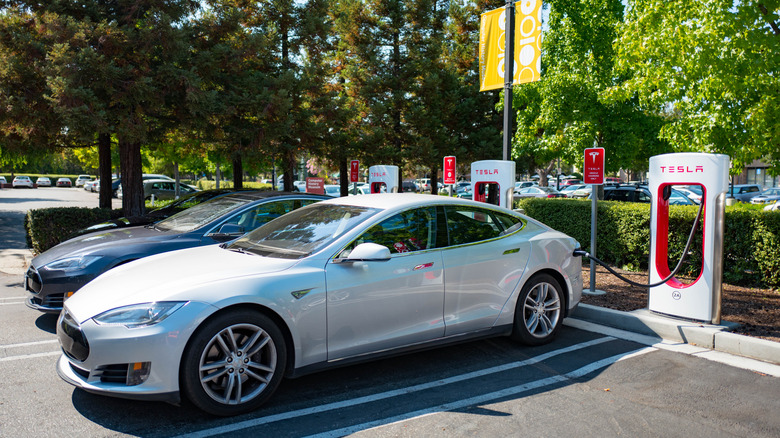
Those who suffer from motion sickness surely saw potential in EVs. On paper, their quiet hum and subtle movements make them seem like they could offer some sweet relief. Sadly, though, scientific research has concluded that travelers may be more susceptible, or have worse symptoms, in an EV. Regardless of your level of comfort on an auto journey, there's no getting away from the fact that driving electric models can feel like a very different experience.
Université de Technologie de Belfort-Montbéliard
PhD researcher William Emond notes, per the Guardian, "when the motion forces as estimated or anticipated by the brain differ from what actually is experienced, then the brain interprets this 'neural mismatch' as a situation of conflict. If this conflict persists over time, it may surpass a threshold for triggering autonomic reactions of the body." An EV, then, doesn't behave as we're 'expecting' a car to, in some instances, which can cause that awful nausea.
It's a curious inverse of another phenomenon: We typically can't tickle ourselves because our brains know what we're about to do, and so what we're about to feel. It's a multi-faceted issue, though, because other EV behaviors can contribute to nausea too. Regenerative braking, a key feature of EVs, is another potential culprit. Ed Kim, AutoPacific president and chief analyst, explained to ABC News that Tesla models can be "very jerky and really abrupt." Motion sickness, as its name would imply, is brought on or made worse by movements, particularly if the motion is abrupt, and regenerative braking, by its nature, can be just that.
Read more: 10 Luxury Cars That Are Cheap To Maintain
Some Reasons For Motion Sickness In Cars

Some types of motion are more likely to bring about the ill effects of motion sickness — this can include unpleasant things like headaches and dizziness as well as the nausea itself — than others. University of Westminster psychology professor Dr. John Golding explained to The Guardian that slower-frequency movements are considered more likely to cause motion sickness in those who are susceptible to it.
These are movements like slow, regular rocking, and they're particularly troublesome for the brain because of the way that they orient us. It can feel that our muscles aren't working and we aren't physically moving, which, when we're in the midst of a journey in a vehicle, is contradicted by visual input. As Dr. Safia Debar of Mayo Clinic Healthcare told the outlet, "this neurological tension is what triggers common symptoms." When it comes to driving in particular, of course, internal combustion engine vehicles can cause these sensory symptoms just as EVs can. The latter, unfortunately, have some traits that tie in with an increased propensity for motion sickness, such as the aforementioned regenerative braking.
One big thing that motion sickness sufferers will tend to avoid while traveling, where possible, is watching screens. Here, again, is the conflict between sitting/focusing on something stationary while, in effect, your environment moves. The resultant disorientation can exacerbate motion sickness. Major electric vehicle brands do have a particular way of imposing some sizable screens on their vehicles, and not only in terms of the driver's controls. CarBuzz's Jared Rosenholtz declared to ABC News in November 2023 that "the BMW i7 is easily my favorite EV interior," with generous features including "a 31-inch theater screen in the back where you can watch Netflix."
Possible Ways To Mitigate Motion Sickness

Those who are particularly susceptible to motion sickness will know just how miserable long journeys can be. Inevitably, there will be times when they can't be avoided. What's needed in such cases are strategies to help manage those symptoms, which can also include cold sweats, irritability, and tiredness. Even if those affected aren't physically vomiting, it's enough to make them feel lousy and utterly ruin a trip, so it's important to do what you can to help yourself (whether in an electric or gas vehicle), just as you would if you were fearful of motion sickness while using VR.
It can be tricky to predict what will help and what won't, and one person's surefire remedy may not provide any relief for another. Common general advice often holds true, though, with the importance of fresh air and, if applicable, a small amount of ginger – perhaps in a supplement – potentially helping to keep sickness at bay. The University of California Davis' Natascha Tuznik advises, per National Geographic, "Look at the horizon if you're out to sea and sit in the front seat of the car where you can see the road and what's coming."
Some carsick EV riders may find that simply getting used to the vehicle will allow their brains and bodies to adjust and their symptoms subside. In the meantime, though, careful and smooth application of regenerative braking may be helpful too. There are remedies that those affected can use to help manage their symptoms, so experiment with your options there, as well as those provided by your vehicle itself, to see what works for you.
Want the latest in tech and auto trends? Subscribe to our free newsletter for the latest headlines, expert guides, and how-to tips, one email at a time.
Read the original article on SlashGear.












